Table of Contents
Introduction: On the Threshold of a New Era
The world is at a critical point of transformation that will define the shape of humanity for decades to come. By 2035, global civilization will experience changes comparable in scale to the Industrial Revolution of the 18th century, but unfolding with unprecedented speed. The convergence of technological breakthroughs, demographic shifts, geopolitical realignment, and the climate crisis creates a unique configuration of challenges and opportunities.
This article is based on interdisciplinary analysis of academic research, forecasts of leading international organizations (UN, OECD, World Economic Forum, McKinsey Global Institute), and big data on trends across various sectors. Our aim is not to predict a deterministic future, but to identify structural patterns and development scenarios that can help us understand the direction of global civilization.
Demographic Revolution: An Aging North, a Young South
Global Demographic Trends
The world’s population will reach approximately 8.9 billion by 2035, but behind this figure lies a dramatic transformation of age structure and geographic distribution.
An aging developed world. High-income countries are experiencing a demographic crisis of historic proportions. By 2035, the number of people over 65 will increase by 36%—from 857 million in 2025 to 1.2 billion. In Europe, around 30% of the population will be over 60; in Japan, more than 35%. China will face the most dramatic scenario: its population will shrink from 1.4 billion in 2025 to 1.3 billion by 2035, with a possible decline to 600 million by 2100.
A youthful Global South. Meanwhile, Africa and parts of Asia are undergoing a demographic explosion. By 2035, Africa’s population will reach 1.7–1.8 billion, and by 2050 will reach 2.2 billion, or 24% of the global population (compared with 9% in 1950). India has already surpassed China as the world’s most populous country and by 2035 will have around 1.5–1.6 billion people.
Socio-Economic Implications
Dependency ratios and economic strain. Aging populations in developed countries will put immense pressure on welfare systems. Europe’s dependency ratio (working-age people to retirees) will fall from 4:1 in 2015 to around 2.5–3:1 by 2035. This will require radical reforms to pensions, healthcare, and eldercare systems.
Urbanization and megacities. By 2035, 68% of the world’s population will live in cities. The number of megacities (over 10 million residents) will rise from 34 in 2024 to 48 in 2035. Fourteen will exceed 20 million inhabitants, with Delhi at the top (43 million) and Tokyo second (36 million).
Most of these megacities will be in developing countries, especially in Africa and Asia. Lagos, Kinshasa, and Dar es Salaam are projected to become the world’s largest urban agglomerations by the end of the 21st century, creating unprecedented challenges for infrastructure, resource management, and social stability.
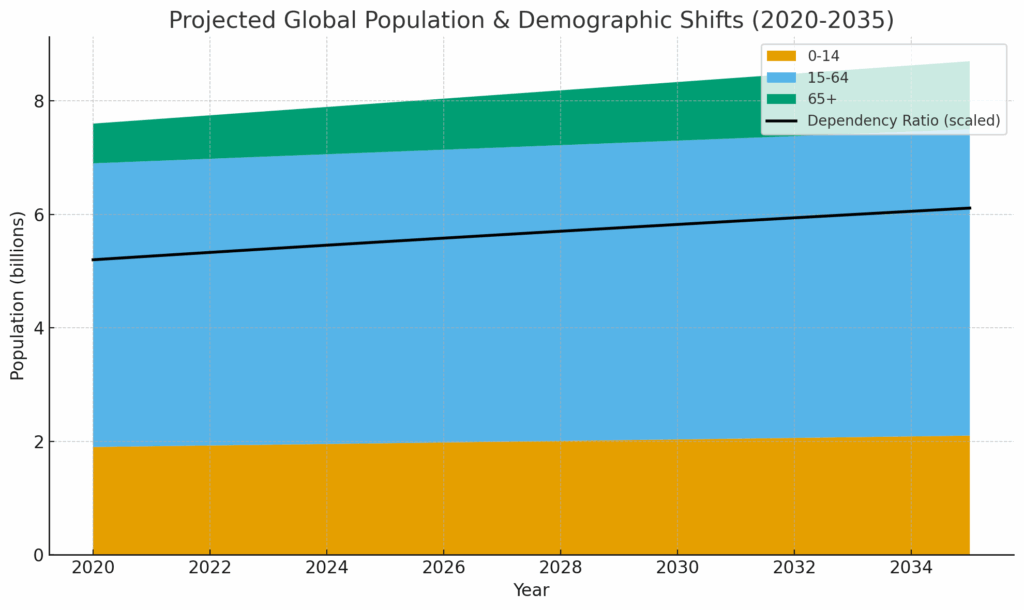
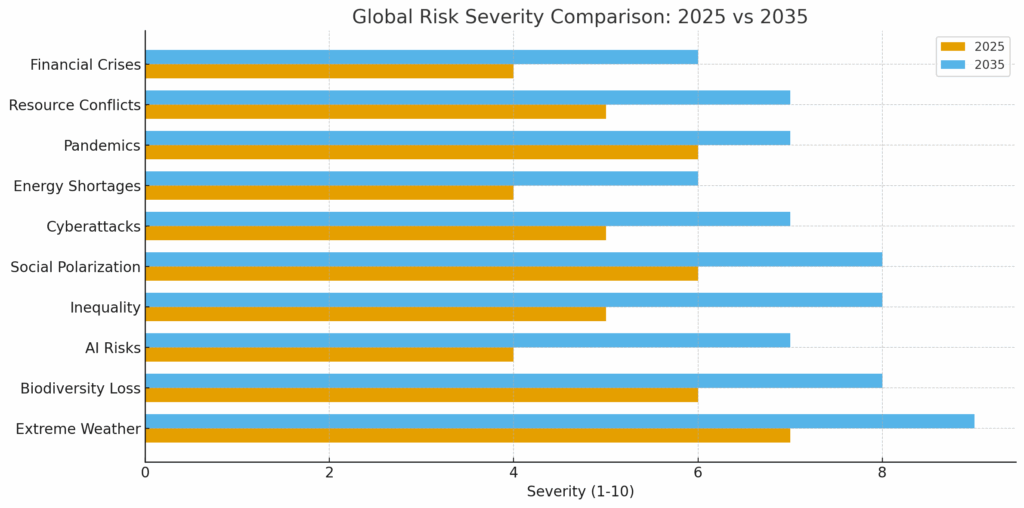
Technological Revolution: Artificial Intelligence and Automation
AI and the Transformation of Work
Artificial intelligence will radically reshape the nature of work by 2035. According to various studies, 30–60% of today’s jobs will be significantly transformed or automated.
The automation paradox. AI will mostly complement rather than replace human labor, especially in high-skill professions. However, routine administrative and clerical roles face high automation risk. Analysis shows that up to 60% of administrative tasks may be automated by the 2030s.
A new geography of opportunity. Jobs requiring creativity, social interaction, leadership, and expertise will be less vulnerable. Demand will grow sharply for AI/ML specialists (projected 57% growth by 2030), renewable energy engineers, data analysts, and AI ethicists.
Productivity and inequality. AI may raise GDP by 1.5% by 2035, nearly 3% by 2055, and 3.7% by 2075. The peak of its productivity impact will come in the early 2030s (adding 0.2 percentage points annually in 2032), before stabilizing. A critical risk is deepening inequality, as AI may widen the gap between high- and low-skilled workers.
Education 2035: Personalization and Lifelong Learning
By 2035, education systems will undergo fundamental transformation.
AI-driven personalization. Ninety-five percent of knowledge assessment will become continuous and competency-based, rather than exam-based. AI tutors will provide 24/7 personalized support to two billion students worldwide. Neuroadaptive interfaces will optimize learning by analyzing brain activity.
Lifelong learning as the norm. The concept of “one education for life” will be obsolete. AI career-navigation systems will recommend training opportunities based on labor market trends, personal aspirations, and evolving skill demands.
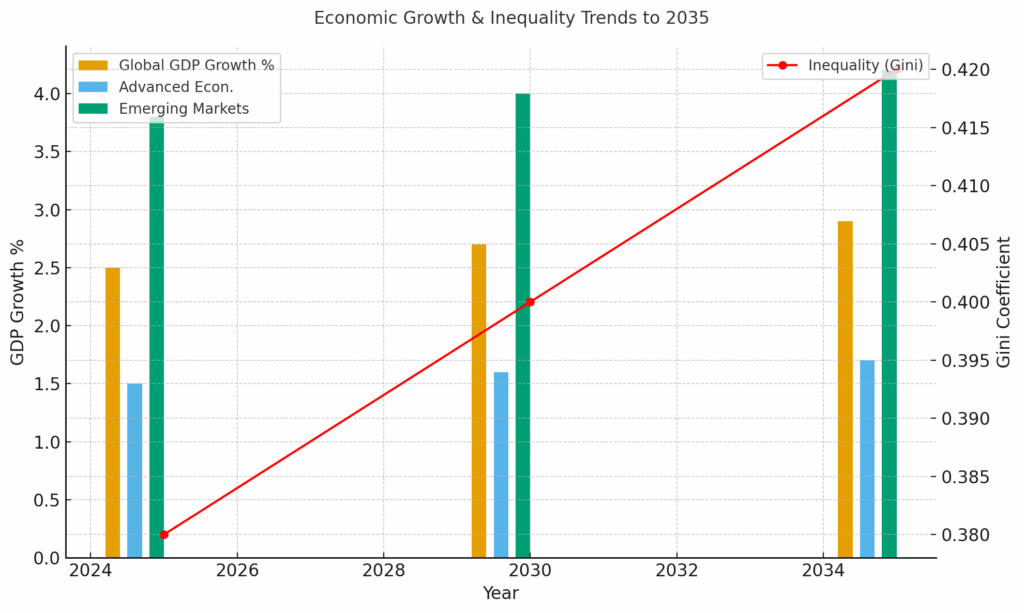
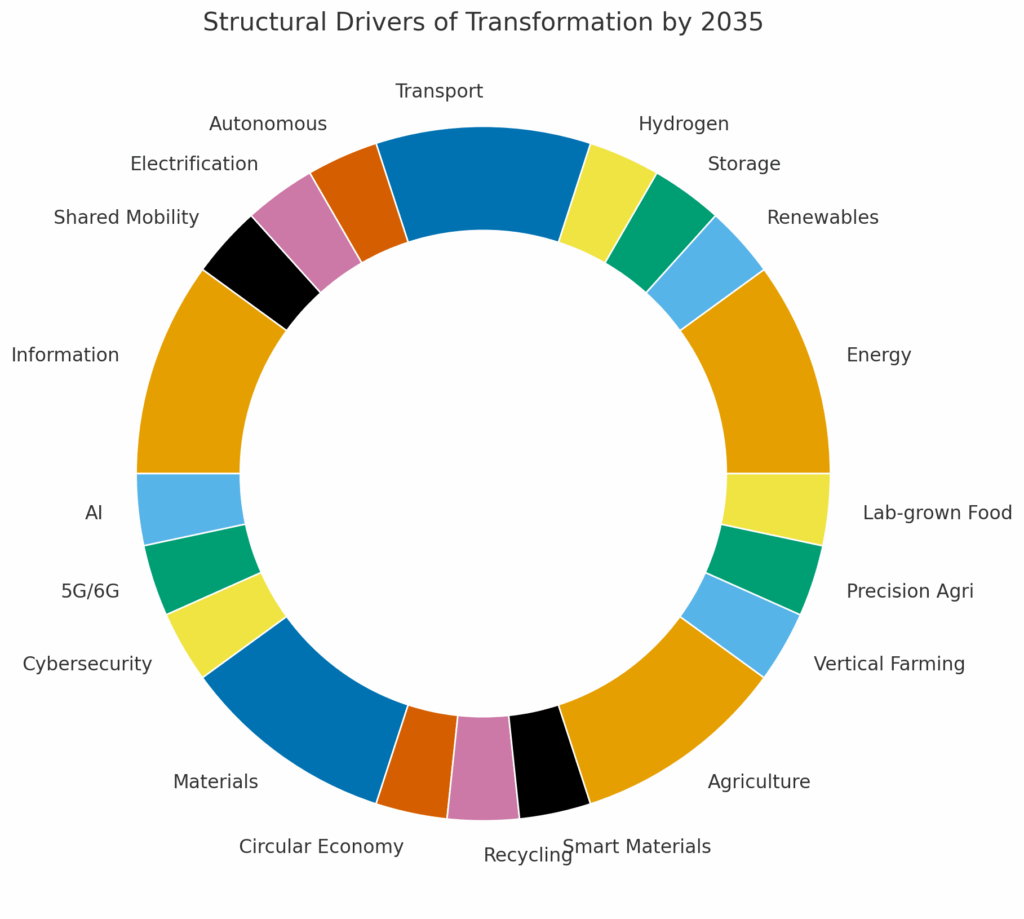
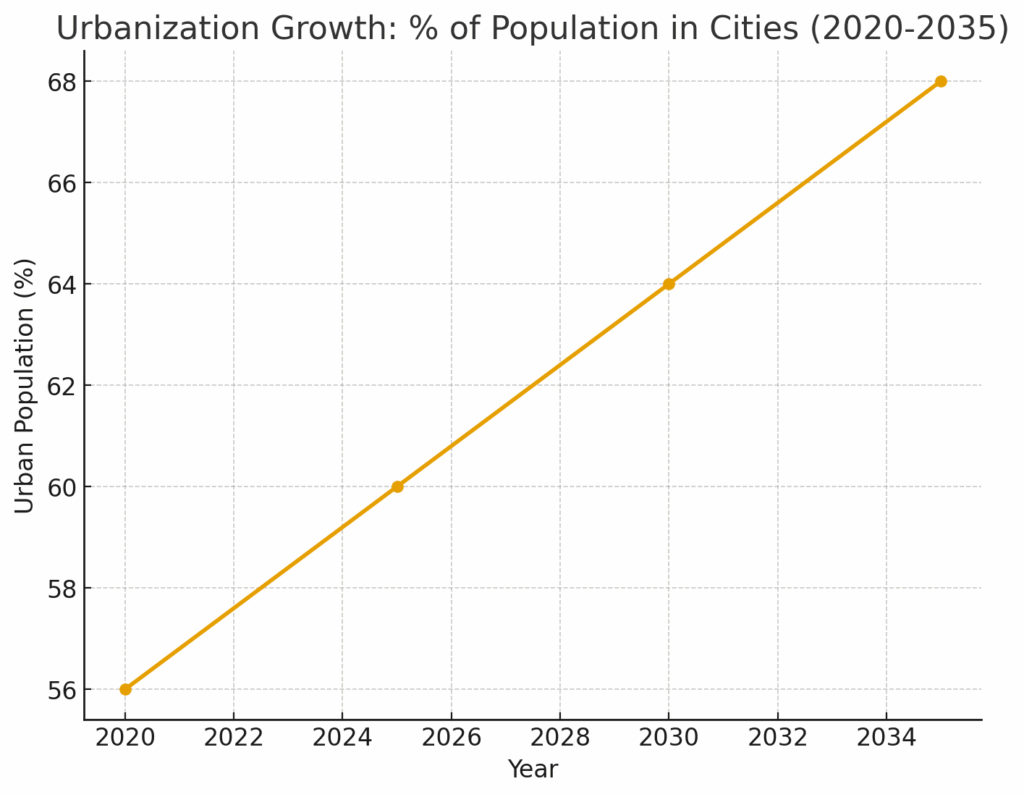
Geopolitical Realignment: A Multipolar World
From Hegemony to Multiple Centers of Power
By 2035, the unipolar order dominated by the United States will be replaced by a multipolar system. Surveys suggest that 73% of global strategy experts expect a multipolar world by 2034, while only 44% foresee a purely bipolar U.S.–China rivalry.
New power centers. China, India, and regional groupings (BRICS+, SCO) are strengthening their influence. Power is also being redistributed to non-state actors such as transnational corporations, megacities, and technology platforms.
Fragmentation of governance. Multilateral institutions (UN, WTO) face a legitimacy crisis. In a worst-case scenario, the UN General Assembly could suspend operations by 2035 due to lack of member-state funding, while the WTO may lose relevance. In a best-case scenario, these institutions adapt to multipolarity through decentralization and inclusion of new actors.
Tech Rivalries and Digital Sovereignty
Decoupled ecosystems. The U.S. and China are building parallel technological ecosystems, including separate 5G/6G networks, competing AI standards, alternative payment systems, and duplicate semiconductor supply chains. Europe is attempting a “third way” through strict regulation (AI Act, GDPR).
Data geopolitics. Data is becoming the new oil, and control over data flows is a matter of national security. By 2035, digital protectionism will be the norm: countries will require data localization and restrict cross-border flows.
Climate Crisis and the Energy Transition
Warming Trajectories and Implications
The planet remains on a trajectory toward 2.2–2.4°C of warming by 2100, and some critical thresholds may be exceeded as early as 2035. Rising global temperatures are already driving ecosystem collapse, worsening extreme weather, and disrupting food and energy security across continents.
Russia as a microcosm.
Russia is both a major emitter and a key climate regulator due to its vast boreal forests, permafrost zones, and energy exports. In August 2025, President Vladimir Putin signed a decree setting a national emissions reduction goal of 65–67% of 1990 levels by 2035, factoring in carbon absorption from forests. This target corresponds to about 2–2.1 gigatons of CO₂ equivalent annually by 2035, which is still 22% higher than Russia’s 2021 emissions.
While Russia officially remains committed to net-zero by 2060, the 2035 interim target is viewed by climate analysts as insufficiently ambitious. The country continues to rely heavily on fossil fuel extraction and exports, risking economic vulnerability as global markets shift toward decarbonization. The thawing permafrost belt, already destabilizing infrastructure in Siberia, will further accelerate emissions through methane release — a largely uncontrollable feedback loop.
Achieving meaningful mitigation would require carbon removal far beyond current capacity. Estimations suggest that offsetting even 100 million tons of CO₂ annually (less than 5% of Russia’s emissions) would demand reforestation of an area equal to the entire Republic of Karelia by 2035 and roughly double that by 2050.
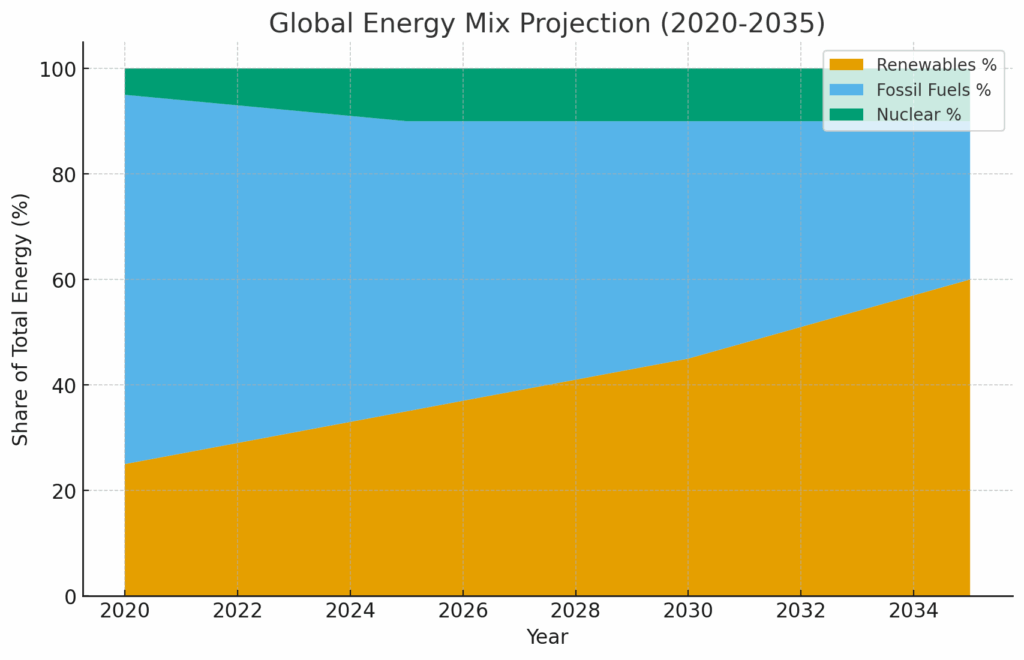
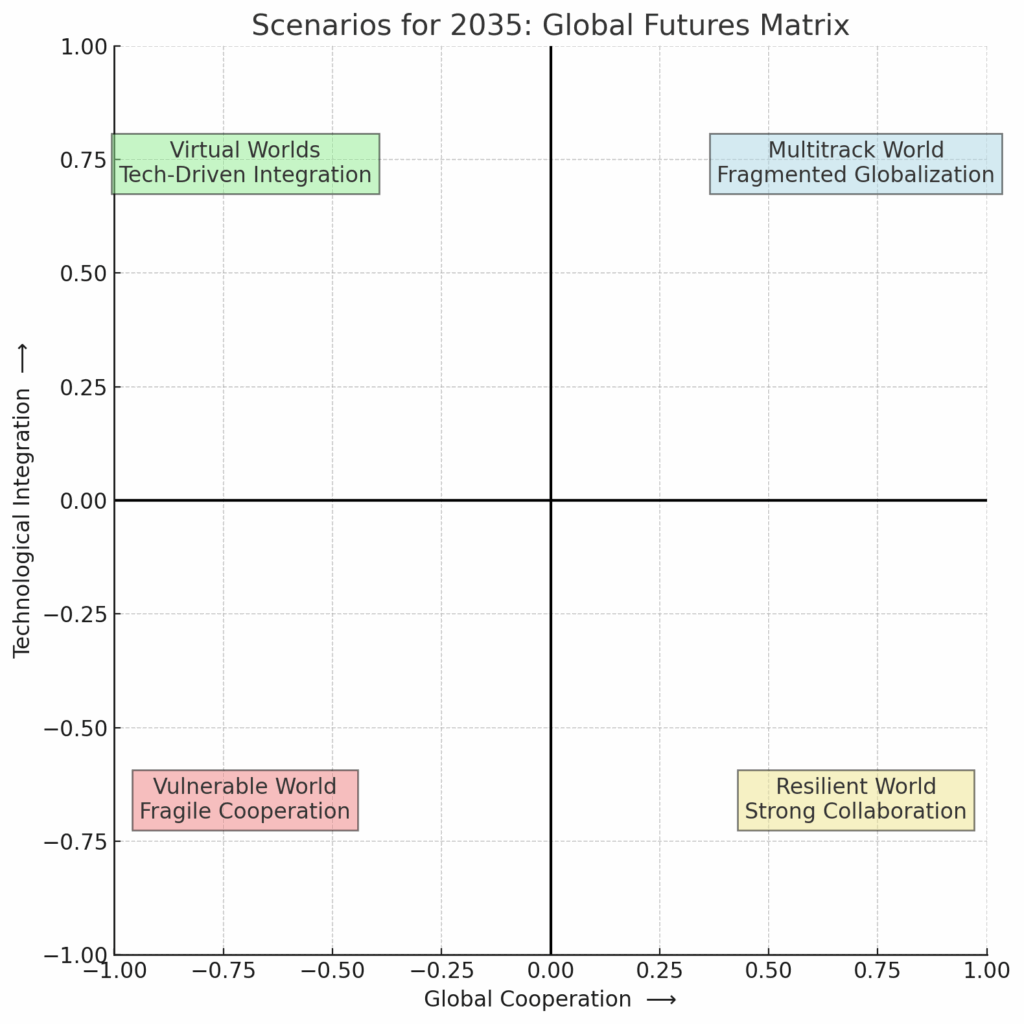
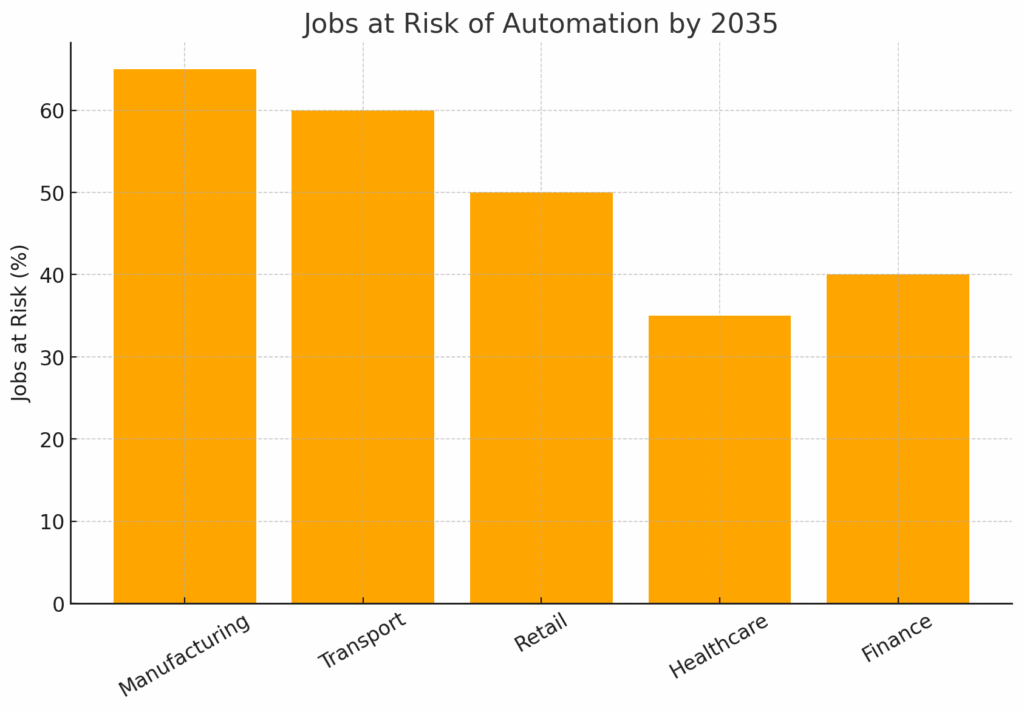
Russia’s Energy Strategy and Fossil Fuel Dependence
Fossil Fuels Dominate Policy
Russia’s Energy Strategy to 2050 (and its precursor, ES‑2035) defines a national trajectory dominated by coal, oil, and gas, projecting fossil fuels to meet 85% of the country’s primary energy consumption by mid-century. Only 1.1% of primary consumption is expected to come from solar and wind by 2050 — ten times less than coal alone.
The government also published two Power Sector Strategies (2025–2030 and 2031–2042), which project wind and solar reaching just 3.3% of electricity generation by 2042. Most renewable output still comes from hydropower, whose share is even expected to decline from 17% today to about 15% by 2035.
Russia maintains its role as an energy superpower, seeking to replace lost European markets with Asia. It plans to increase LNG capacity from 27 million to 140 million tons per year by 2035, while Arctic extraction becomes a strategic priority as melting ice opens access to hydrocarbons.
However, experts warn these assumptions are detached from international demand trends and risk locking Russia into economic stagnation and technological backwardness.
Renewable Energy and Digital Transformation
Although Russia’s energy policy lags global decarbonization, there is movement toward modernization and efficiency. Deputy Prime Minister Alexander Novak announced in 2025 that Russia aims to achieve full digitalization of its energy sector by 2035, implementing automation, robotics, and AI‑driven control systems. This initiative is expected to support energy efficiency, network optimization, and transparency in a system burdened by losses and outdated infrastructure.
Nuclear energy remains Russia’s strongest low‑carbon sector, currently accounting for 19% of power generation and expected to grow considerably through domestic expansion and exports of new‑generation reactors to partner countries under Rosatom’s international portfolio.
The End of Coal and Global Shifts
While the global share of coal will decline sharply by mid‑century, Russia continues to promote coal exports as a strategic fiscal buffer, projecting to become the world’s largest exporter by 2035. Domestically, there are few plans to retire coal power plants in the 2030s, unlike the European Union’s 2035–2040 coal phase‑out targets.
At the same time, global energy flows are decoupling from fossil‑based economies: Asia and the Middle East will demand less imported oil by 2040, and renewable energy investment exceeded fossil fuel investment worldwide in 2024 for the first time. Russia’s continued emphasis on oil and gas risks alienating it from emerging clean‑tech markets worth trillions of dollars annually by the 2030s.
Energy Storage and Infrastructure Modernization
As Russia digitalizes its energy system, most smart‑grid technology advances are concentrated in pilot projects in Moscow, Tatarstan, and Tyumen. The government’s digitalization roadmap envisions:
Approximately 6–8 gigawatts of distributed energy storage integrated by 2035, primarily from industrial consumers and localized systems;
Expansion of high‑voltage smart metering and predictive control algorithms for industrial power distribution;
Gradual integration of hydrogen pilot projects into industrial clusters, aligned with the Hydrogen Roadmap 2035 approved by the government in 2021.
Economic Cost and Long-Term Outlook
Russia’s fossil-fuel-centric development path is increasingly incompatible with global investment trends. While the EU, US, and China channel hundreds of billions toward energy transition technologies, Russia invests comparatively little in renewables or energy efficiency—typically under 1% of annual federal energy-sector spending.
Analysts estimate that for Russia to align with even a moderate 1.5–2°C scenario, it would need to mobilize $100–150 billion annually through 2050 for low-carbon infrastructure — a scale comparable to its entire annual fossil fuel export revenue.
Instead, current investments prioritize new oil pipelines, LNG terminals, and Arctic extraction facilities, which may yield short-term fiscal benefits but structural long-term risks.
Summary
Russia’s 2035 goal: Reduce emissions 33–35% below 1990 levels (to 2.0–2.1 Gt CO₂e/year).
Fossil fuels: Still projected to supply 85% of primary energy by 2050.
Renewables: Wind and solar below 4% of the mix by 2035; hydro at 15%.
Nuclear energy: To expand as Russia’s main low-carbon asset.
Digitalization: Full smart grid and automation of energy systems by 2035 target.
Arctic Strategy: Accelerated resource extraction under warming conditions.
Global risk: Long-term competitiveness erosion amid accelerating decarbonization elsewhere.
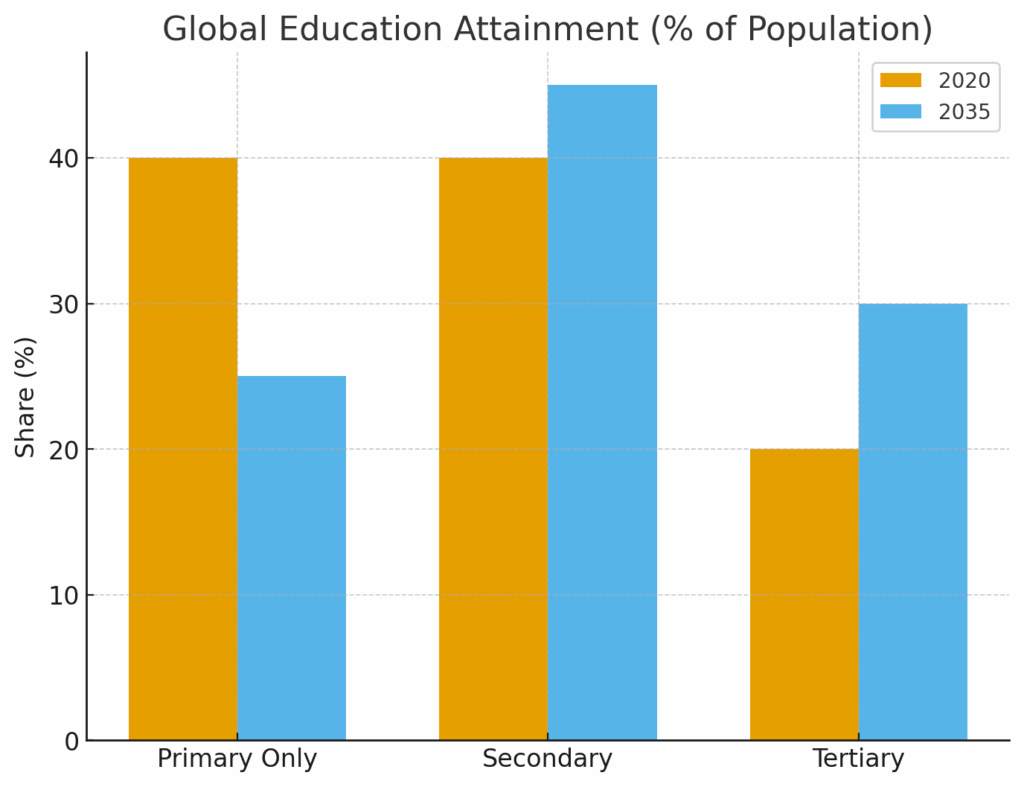
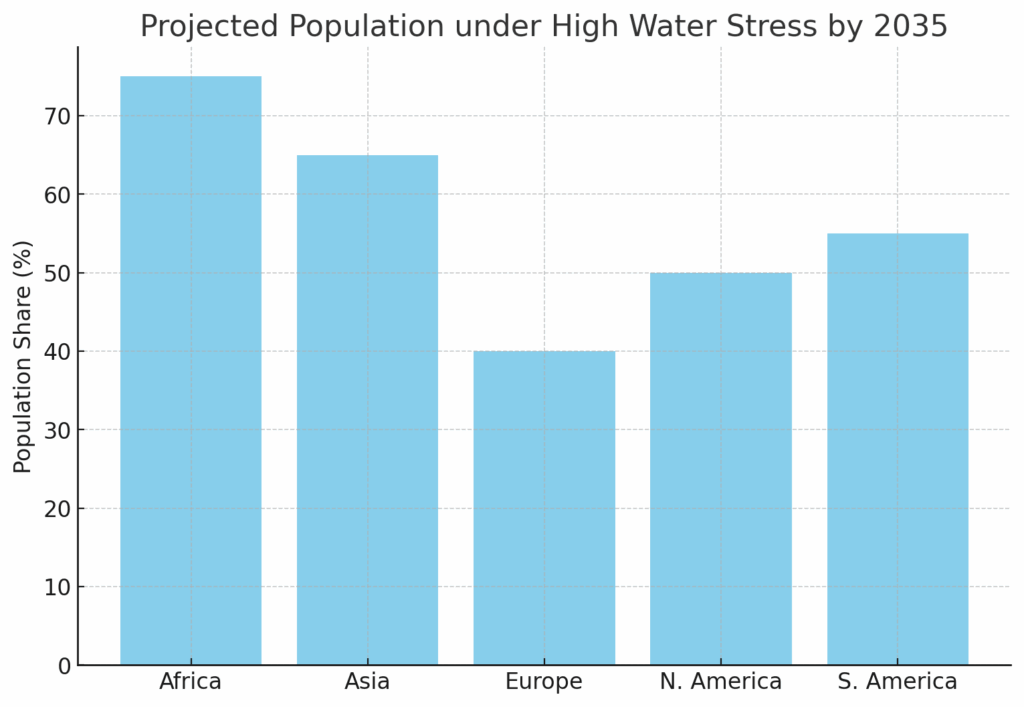
Smart Cities and Urban Transformation
By 2035, the concept of the “smart city” will evolve from technocratic efficiency to human-centered urbanism.
Technology integration. Digital twins, AI-optimized transport, and IoT sensor networks will be standard. Seoul uses augmented intelligence for predictive resource modeling; Barcelona saves over $80 million annually through smart water and parking systems.
Challenges of inclusivity. A key risk is the “digital divide,” where benefits accrue to elites while vulnerable groups are excluded. Amsterdam, Tokyo, Medellín, and Toronto demonstrate more inclusive models through citizen participation.
Regulatory challenges. Open data, privacy, and cybersecurity demand new frameworks balancing innovation with civil rights.
Family and Social Relations
Pluralization of Family Forms
By 2035, the nuclear family will no longer dominate in developed countries. New family models will rise:
Same-sex families (following widespread legalization)
Shared custody families after divorce
Grandparent-headed households
Single-person households (especially youth and elderly)
Transnational families (parents working abroad)
Digitalization of family ties. Apps and video communication will become central to maintaining family bonds, especially in geographically dispersed families.
Fertility Crisis and Consequences
Global fertility decline. Fertility is falling across almost all regions. Even traditionally high-birthrate societies are undergoing rapid demographic transitions.
Kinlessness. A growing share of people will have no children or close relatives. By 2035, this will create crises for care and support systems traditionally based on family networks.
Delayed parenthood and careers. In urban China, the share of stay-at-home mothers is rising, especially among highly educated women who can “afford” a single-earner model. This reflects a deepening gender division of labor, despite economic progress.
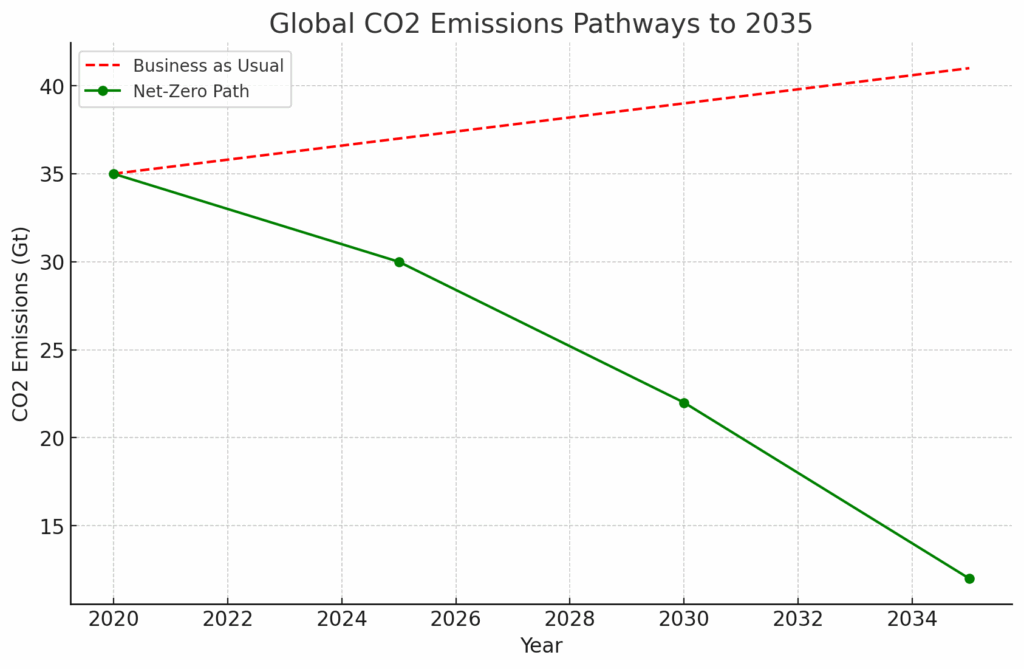
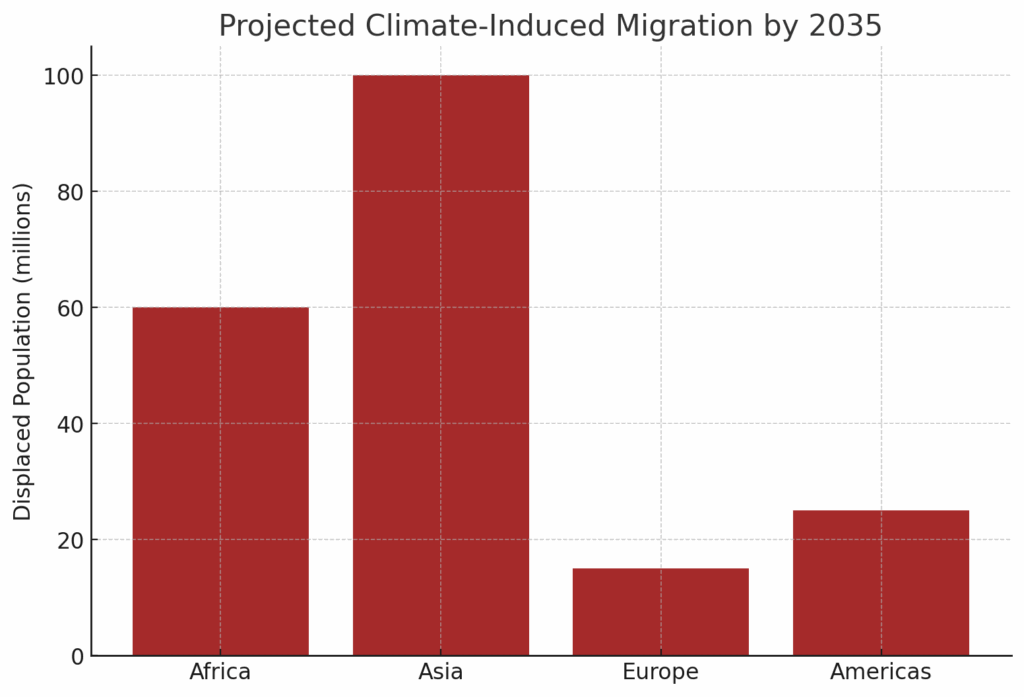
Inequality: Economic and Digital Gaps
Wealth Divide
Wealth inequality grows faster than income inequality.
In Australia, the top 10% of households increased their average wealth from $2.8 million to $5.2 million (+84%) in 20 years, while the bottom 60% rose from $222,000 to $343,000 (+55%). Almost half (45%) of total wealth growth since 2003 went to the top 10%.
Among youth under 35, inequality is especially stark. They hold only 5% of total wealth, with the top 10% increasing their wealth from $928,000 to $2 million (+126%), while the bottom 60% grew only from $12,000 to $80,000 (+39%).
Housing crises exclude much of the younger generation from ownership, entrenching inequality.
Digital Divide
Access to AI and education is uneven. Without broadband, computing power, and digital literacy, entire regions risk marginalization.
Negative 2035 scenario: tax havens triple, middle classes collapse, elites monopolize AI and healthcare, inequality becomes normalized.
Positive scenario: cultural shifts in management, narrowing gender pay gaps, universal basic income, demand for sustainable goods, and global tax reform reduce inequality.
Healthcare and Mental Health
Longevity and Personalized Medicine
By 2035, healthcare will shift from reactive to proactive models.
AI diagnostics surpassing human accuracy
Genomics-driven personalized medicine
Continuous monitoring via wearables
Telemedicine as standard
The longevity biotech market will expand from $28.9 billion in 2025 to $52.9 billion in 2035. Anti-aging therapies (epigenetic reprogramming, telomere extension) may extend healthy life beyond 120 years.
Mental Health Crisis
By 2035, the world will face a mental health crisis of unprecedented scale.
Risk factors: urbanization and isolation, digital addiction, job insecurity, long-term COVID-19 impacts, climate anxiety.
Policy responses (e.g., UK plan): integrate mental health into primary care, address social determinants (housing, jobs, education), provide psychosocial support as a basic service, expand digital access to care, and fight stigma.
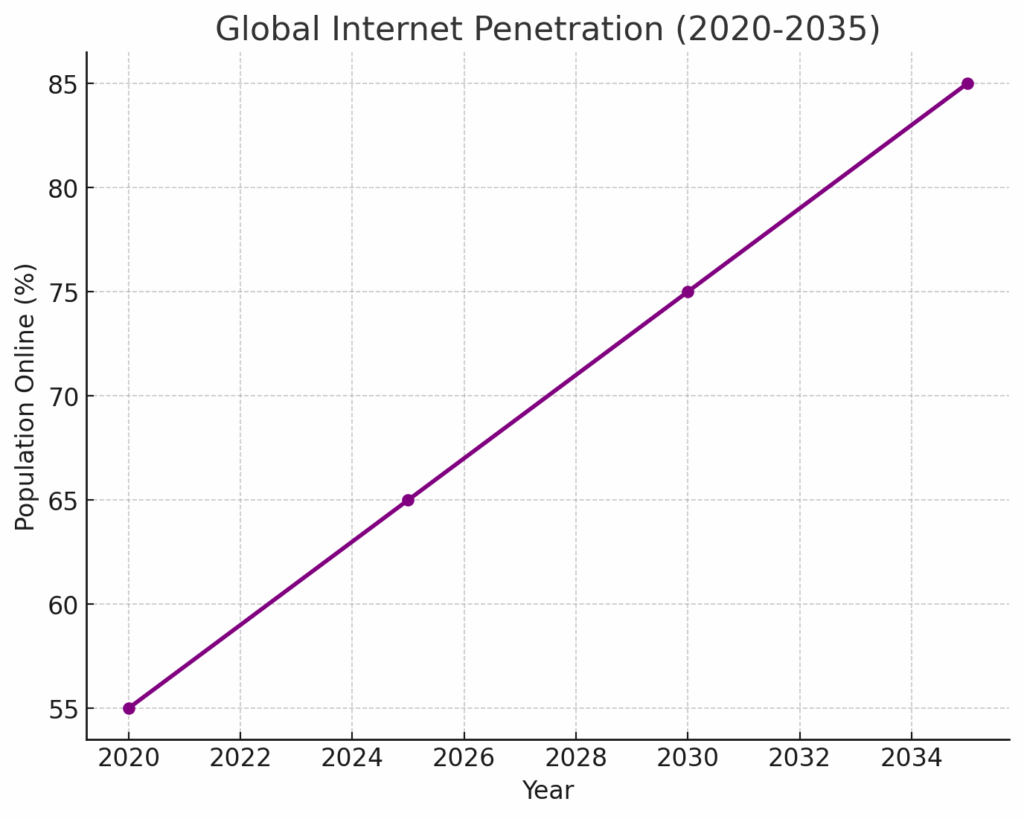
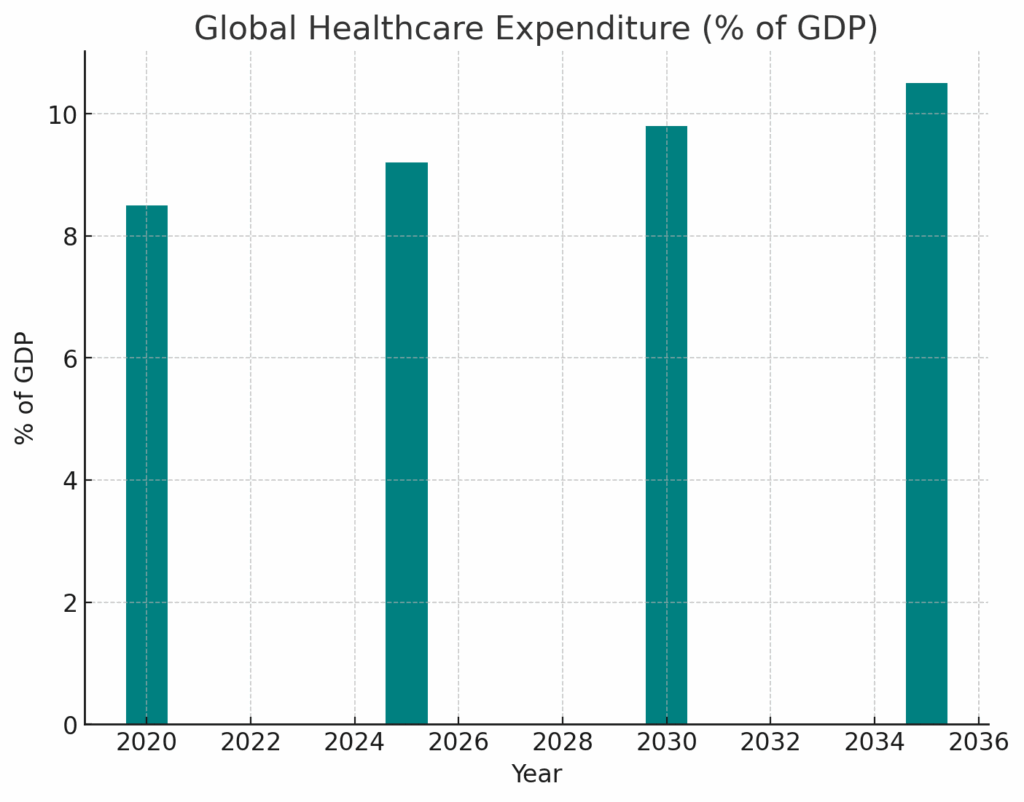
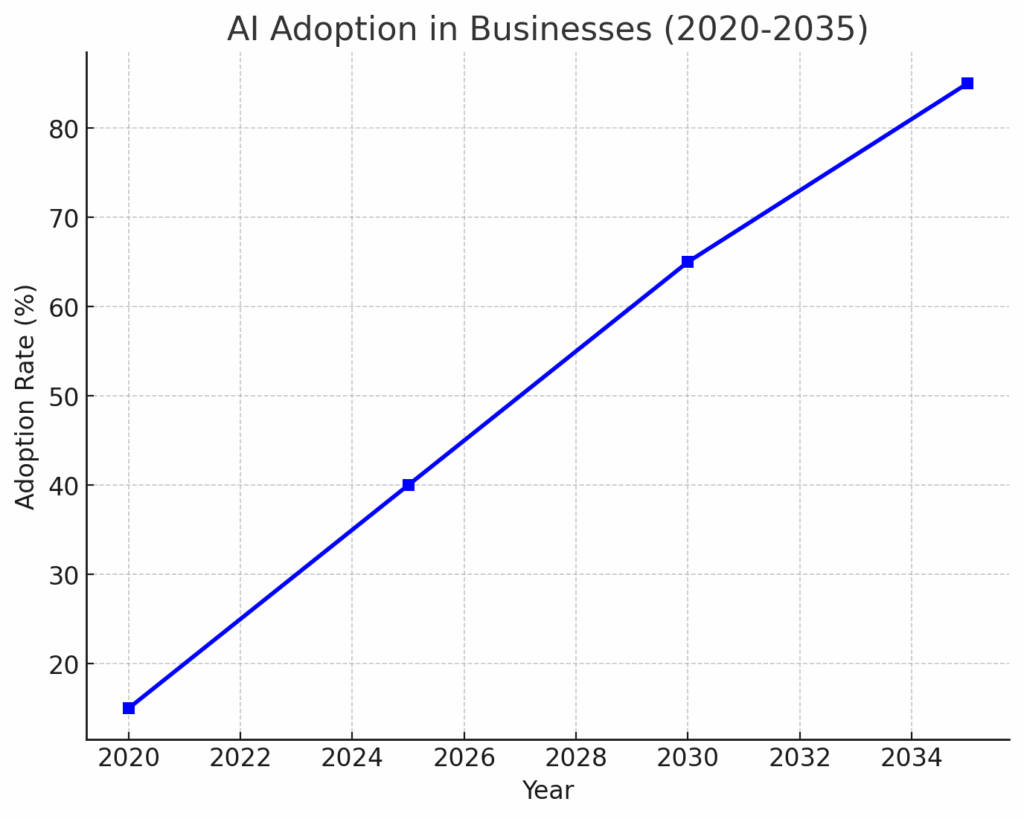
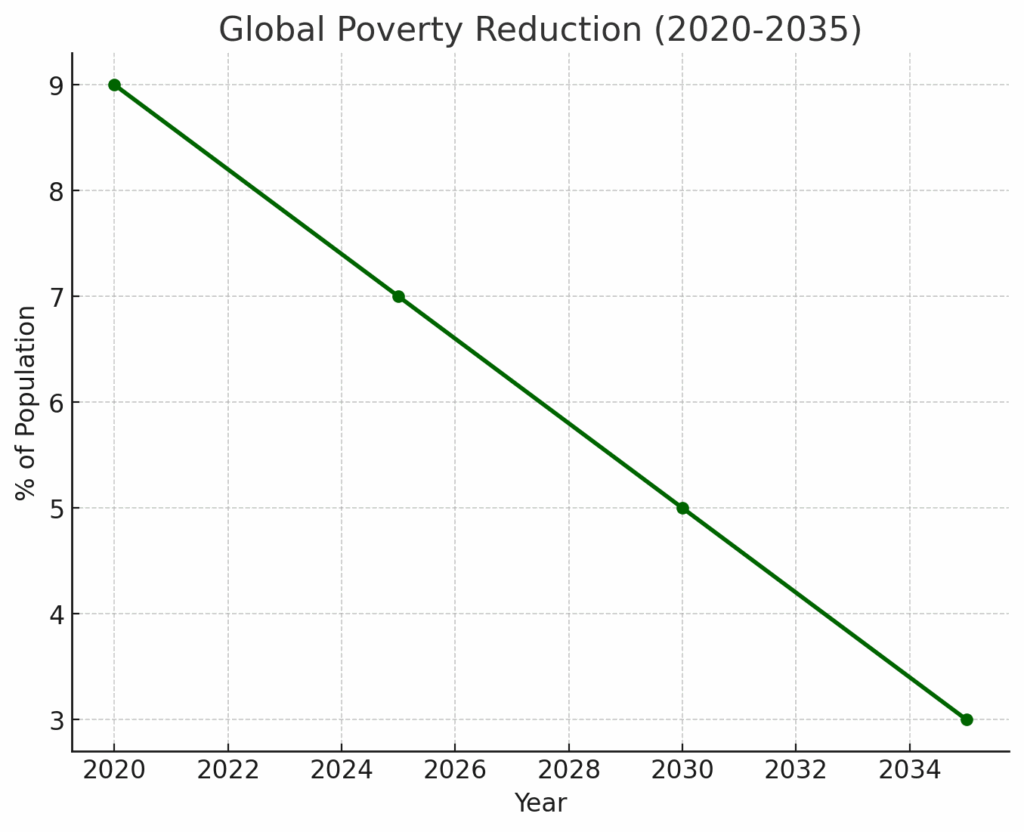
Food Systems and Synthetic Biology
Disruption of Livestock
By 2030–2035, precision fermentation and cellular agriculture will make proteins 5–10 times cheaper than animal sources.
Food-as-Software model. Engineered microbes will produce proteins, fats, and vitamins on demand, decentralizing food production and making it more sustainable and personalized.
Land freed. Up to 80% of farmland (equivalent to the U.S., China, and Australia combined) may be released for rewilding, reforestation, and carbon sequestration.
Synthetic Biology in Agriculture
The market may reach $85 billion by 2035. Key innovations:
Self-fertilizing crops
Drought-resistant plants
Crops absorbing more CO₂
Biological pest control
Saltwater agriculture
Risks and ethics. Releasing GMOs into the environment raises biosecurity and ethical dilemmas, requiring strong regulation.
Water Crisis and Resource Conflicts
By 2035, water stress will be a major driver of instability.
Fourteen of the 33 most water-stressed nations by 2040 will be in the Middle East. Nine already face extreme stress (Bahrain, Kuwait, Palestine, Qatar, UAE, Israel, Saudi Arabia, Oman, Lebanon).
Drought and water scarcity contributed to Syria’s 2011 unrest and civil war. Water remains central to the Israel–Palestine conflict.
Climate change may displace 150 million people globally by 2035, many due to water scarcity.
Geoengineering. Cloud seeding, microclimate control, and ecosystem restoration will expand, but unilateral actions risk conflict if rainfall is diverted from neighbors.
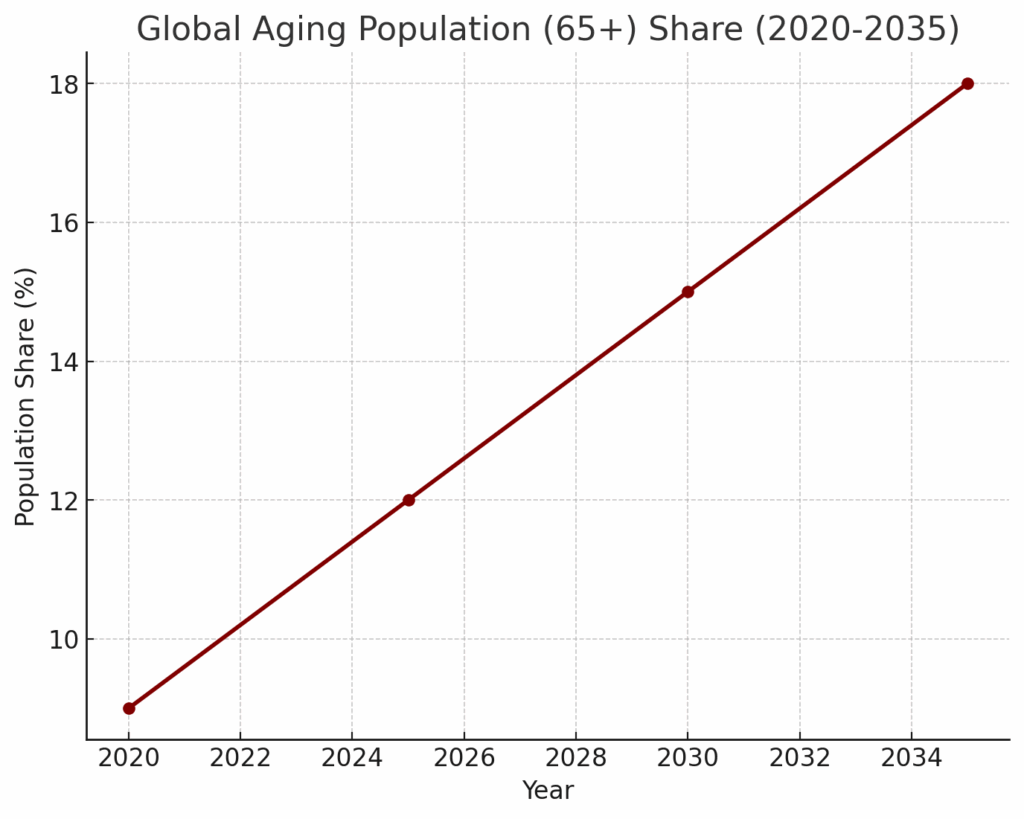
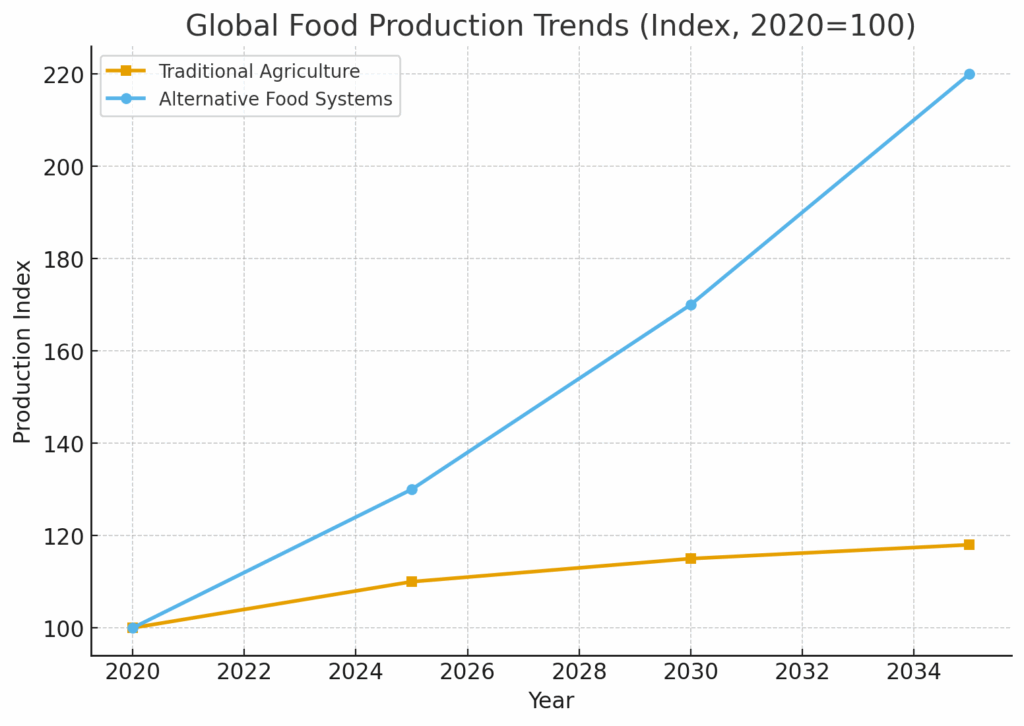
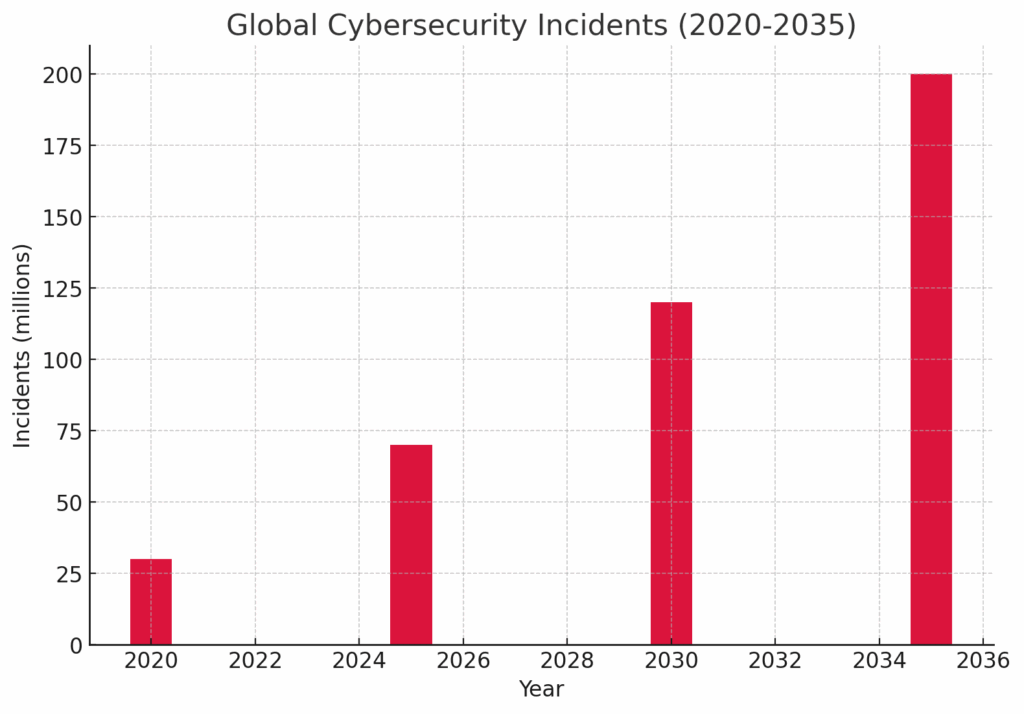
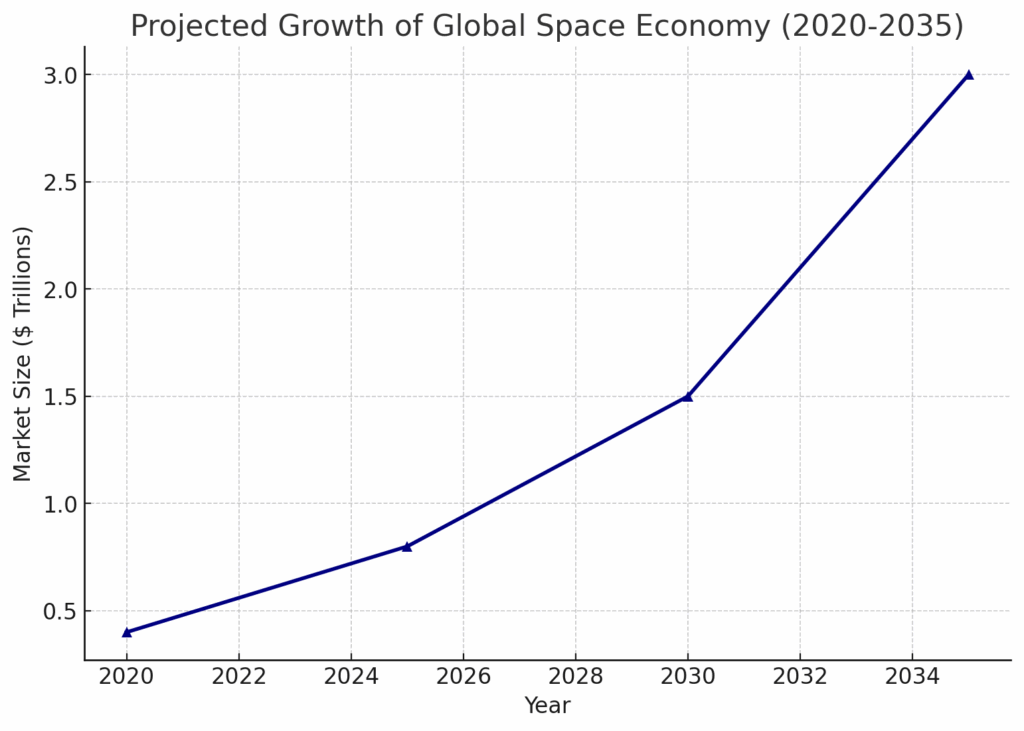
Space Expansion: First Steps Toward an Interplanetary Civilization
By 2035, humanity will take decisive steps beyond Earth.
Artemis program (NASA): sustainable lunar presence by 2030, focusing on habitats, resource extraction, and research.
Mars 2035: first crewed missions will arrive, with 3D-printed robotic habitats ready for occupation. Populations may reach dozens of humans and robots by 2040.
Space economy: valued at $546 billion in 2023, projected to surpass $1 trillion by 2040, with sectors such as asteroid mining, space logistics, and off-Earth manufacturing.
The Metaverse and Digital Economy
By 2035, physical and virtual realities will blur.
Scenarios
Unitechnocracy: dual systems of CBDCs and private assets, tokenized economies, AI-driven allocation, metaverse as escape.
BINO (Blockchain in Name Only): centralized, cashless societies with collapsed open blockchains.
Pluribus: decentralized crypto coexisting with legacy systems, DNA-based ID across multiple metaverses.
DAO-Mundus: nation-states fade, DAOs govern communities, social life moves largely into virtual realities.
Economic Potential
The metaverse could reach a $4.4 trillion market by 2030 (optimistic scenario).
Industrial metaverse applications may reach $150 billion by 2035.
Digital collectibles (NFTs) will grow from $10.9 billion in 2025 to $54 billion in 2035, evolving from speculation to utility, integrated with identity, loyalty, and AI customization.
Conclusion: Navigating Uncertainty
By 2035, the world will be radically different across demographics, technology, geopolitics, ecology, and society.
Key transformation patterns:
Demographic divergence: aging North, youthful South, migration pressures.
AI revolution: automation, personalized education, inequality risks.
Multipolar geopolitics: decline of U.S. hegemony, rise of China, India, blocs.
Climate imperative: energy transition requiring trillions in investment.
Urbanization: 68% in cities, 48 megacities, infrastructure strains.
Family pluralization: end of nuclear dominance, digital ties, fertility crisis.
Inequality crossroads: deepening divides vs. inclusive reforms.
Healthcare revolution: personalized medicine vs. mental health epidemic.
Food transformation: synthetic biology, rewilding.
Water crisis: instability, migration, conflict.
Space expansion: first steps to interplanetary life.
Metaverse: blurred realities, new economies and governance.
Future Scenarios. Outcomes range from inclusive multipolarity, green economies, and AI augmenting human potential—to fragmentation, conflict, climate collapse, and digital authoritarianism.
The decisions made today—in climate policy, AI regulation, social protection, education, and international cooperation—will determine the path. Human agency and leadership will shape the outcome.
The world of 2035 will be one of complexity, plurality, and uncertainty. The capacity to adapt, learn, and collaborate across borders and differences will define prosperity—for individuals and societies alike. Those who embrace complexity and invest in resilience, innovation, and inclusivity will be best positioned to navigate this transformative era that has already begun.







